
Schumacher SC1305 Automatic Battery Charger
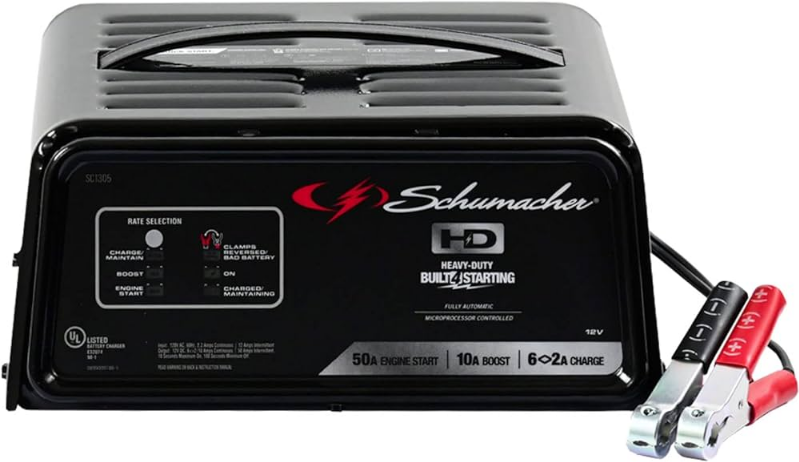
IMPORTANT SAFETY INSTRUCTIONS
SAVE THESE INSTRUCTIONS.
- SAVE THESE INSTRUCTIONS –
This manual contains important safety and operating instructions. - Keep out of reach of children.
- Do not expose the charger to rain or snow.
- Use of an attachment not recommended or sold by the battery charger manufacturer may result in a risk of fire, electric shock, or injury to persons.
- To reduce the risk of damage to the electric plug and cord, pull by the plug rather than the cord when disconnecting the charger.
- An extension cord should not be used unless necessary. Use of an improper extension cord could result in a risk of fire and electric shock. If an extension cord must be used, make sure:
- The pins on the plug of the extension cord are the same number, size, and shape as those of the plug on the charger.
- The extension cord is properly wired and in good electrical condition
- The wire size is large enough for the AC ampere rating of the charger as specified in section 8.
- Do not operate the charger with a damaged cord or plug – replace the cord or plug immediately.
- Do not operate the charger if it has received a sharp blow, been dropped, or otherwise damaged in any way; take it to a qualified serviceman.
- Do not disassemble the charger; take it to a qualified serviceman when service or repair is required. Incorrect reassembly may result in a risk of electric shock or fire.
- To reduce the risk of electric shock, unplug the charger from the outlet before attempting any maintenance or cleaning. Turning off controls will not reduce this risk.
- WARNING:
RISK OF EXPLOSIVE GASES.- WORKING IN THE VICINITY OF A LEAD-ACID BATTERY IS DANGEROUS. BATTERIES GENERATE EXPLOSIVE GASES DURING NORMAL BATTERY OPERATION. FOR THIS REASON, IT IS OF UTMOST IMPORTANCE THAT YOU FOLLOW THE INSTRUCTIONS EACH TIME YOU USE THE CHARGER.
- To reduce the risk of battery explosion, follow these instructions and those published by the battery manufacturer and the manufacturer of any equipment you intend to use in the vicinity of the battery.. Review cautionary markings on these products and on the engine.
PERSONAL SAFETY PRECAUTIONS
- Consider having someone close enough by to come to your aid when you work near a lead-acid battery.
- Have plenty of fresh water and soap nearby in case battery acid contacts skin, clothing, or eyes.
- Wear complete eye and clothing protection. Avoid touching your eyes while working near a battery.
- If battery acid contacts skin or clothing, wash immediately with soap and water. If acid enters the eye, immediately flood the eye with running cold water for at least 10 minutes and get medical attention immediately.
- NEVER smoke or allow a spark or flame in the vicinity of the battery or engine.
- Be extra cautious to reduce the risk of dropping a metal tool onto the battery. It might spark or short-circuit the battery or other electrical parts, which may cause an explosion.
- Remove personal metal items such as rings, bracelets, necklaces, and watches when working with a lead-acid battery. A lead-acid battery can produce a short-circuit current high enough to weld a ring or the like to metal, causing a severe burn.
- Use a charger for charging only LEAD-ACID (STD or AGM) rechargeable batteries with recommended rated capacities of
22-59Ah (12V). It is not intended to supply power to a low-voltage electrical system other than in a starter-motor application. Do not use a battery charger for charging dry-cell batteries that are commonly used with home appliances. These batteries may burst and cause injury to persons and property damage. - NEVER charge a frozen battery.
- WARNING: This product contains one or more chemicals known to the State of California to cause cancer and birth defects or other reproductive harm.
PREPARING TO CHARGE
- If necessary to remove the battery from the vehicle to charge, always remove the grounded terminal from the battery first. Make sure all accessories in the vehicle are off, so as not to cause an arc.
- Be sure the area around the battery is well ventilated while the battery is being charged.
- Clean battery terminals. Be careful to keep corrosion from coming in contact with your eyes.
- Add distilled water in each cell until the battery acid reaches the level specified by the battery manufacturer. Do not overfill. For a battery without removable cell caps, such as valve-regulated lead-acid batteries, carefully follow the manufacturer’s recharging instructions.
- Study all battery manufacturers’ specific precautions while charging and recommended rates of charge.
- Determine the voltage of the battery by referring to the car owner’s manual, and make sure that the output voltage selector switch is set at the correct voltage. If the charger has an adjustable charge rate, charge the battery initially at the lowest rate.
CHARGER LOCATION
- Locate the charger as far away from the battery as DC cables permit.
- Never place the charger directly above the battery being charged; gases from the battery will corrode and damage the charger.
- Never allow battery acid to drip on the charger when reading electrolyte specific gravity or filling the battery.
- Do not operate the charger in a closed-in area or restrict ventilation in any way.
- Do not set a battery on top of a charger.
DC CONNECTION PRECAUTIONS
- Connect and disconnect DC output clips only after setting any charger switches to the “off” position and removing the AC cord from the electric outlet. Never allow clips to touch each other.
- Attach clips to the battery and chassis, as indicated in sections 6 and 7.
FOLLOW THESE STEPS WHEN THE BATTERY IS INSTALLED IN THE VEHICLE
WARNING: A SPARK NEAR THE BATTERY MAY CAUSE A BATTERY EXPLOSION. TO REDUCE THE RISK OF A SPARK NEAR THE BATTERY:
- Position the AC and DC cords to reduce the risk of damage from the hood, door, or moving engine parts.
- Stay clear of fan blades, belts, pulleys, and other parts that can cause injury to persons.
- Check the polarity of battery posts. POSITIVE (POS, P, +) battery post usually has a larger diameter than NEGATIVE (NEG, N,–) post.
- Determine which post of the battery is grounded (connected) to the chassis. If the negative post is grounded to the chassis (as in most vehicles), see (6.5). If a positive post is grounded to the chassis, see (6.6).
- For a negative-grounded vehicle, connect the POSITIVE (RED) clip from the battery charger to the POSITIVE (POS, P, +) ungrounded post of the battery. Connect NEGATIVE (BLACK) clip to vehicle chassis or engine block away from battery. Do not connect the clip to the carburetor, fuel lines, or sheet-metal body parts. Connect to a heavy-gauge metal part of the frame or engine block.
- For a positive-grounded vehicle, connect the NEGATIVE (BLACK) clip from the battery charger to the NEGATIVE (NEG, N, –) ungrounded post of the battery. Connect the POSITIVE (RED) clip to the vehicle chassis or engine block away from the battery. Do not connect the clip to the carburetor, fuel lines, or sheet-metal body parts. Connect to a heavy-gauge metal part of the frame or engine block.
- When disconnecting the charger, turn the switches off, disconnect the AC cord, remove the clip from the vehicle chassis, and then remove the clip from the battery terminal.
- See Operating Instructions for length of charge information.
FOLLOW THESE STEPS WHEN THE BATTERY IS OUTSIDE THE VEHICLE
WARNING: A SPARK NEAR THE BATTERY MAY CAUSE A BATTERY EXPLOSION. TO REDUCE THE RISK OF A SPARK NEAR THE BATTERY:
- Check the polarity of battery posts. POSITIVE (POS, P, +) battery post usually has a larger diameter than NEGATIVE (NEG, N, –) post.
- Attach at least a 24-inch-long 6-gauge (AWG) insulated battery cable to the NEGATIVE (NEG, N, –) battery post.
- Connect POSITIVE (RED) charger clip to POSITIVE (POS, P, +) post of battery.
- Position yourself and free end of cable as far away from the battery as possible – then connect NEGATIVE (BLACK) charger clip to the free end of the cable.
- Do not face the battery when making the final connection.
- When disconnecting the charger, always do so in the reverse sequence of the connecting procedure and break the first connection while as far away from the battery as practical.
- A marine (boat) battery must be removed and charged on shore. To charge it on board requires equipment specially designed for marine use.
GROUNDING AND AC POWER CORD CONNECTIONS
- This battery charger is for use on a nominal 120-volt circuit and has a grounded plug. The charger must be grounded to reduce the risk of electric shock. The plug must be plugged into an outlet that is properly installed and grounded by all local codes and ordinances. The plug pins must fit the receptacle (outlet). Do not use with an ungrounded system.
- DANGER: Never alter the AC cord or plug provided – if it does not fit the outlet, have a proper grounded outlet installed by a qualified electrician. An improper connection can result in a risk of an electric shock or electrocution.
NOTE: Under Canadian Regulations, the use of an adapter plug is not allowed in Canada. Use of an adapter plug in the United States is not recommended and should not be used. - USING AN EXTENSION CORD
The use of an extension cord is not recommended. If you must use an extension cord, follow these guidelines:- Pins on the plug of the extension cord must be the same number, size, and shape as those of the plug on the charger.
- Ensure that the extension cord is properly wired and in good electrical condition.
- Wire size must be large enough for the AC ampere rating of the charger, as specified:
 *AWG-American Wire Gauge
*AWG-American Wire Gauge
ASSEMBLY INSTRUCTIONS
- Remove all cord wraps and uncoil the cables before using the battery charger.
CONTROL PANEL
LED INDICATORS
![]() CLAMPS REVERSED/ BAD BATTERY (red) LED flashing:
CLAMPS REVERSED/ BAD BATTERY (red) LED flashing:
The connections are reversed.
![]() CLAMPS REVERSED/ BAD BATTERY (red) LED lit:
CLAMPS REVERSED/ BAD BATTERY (red) LED lit:
The charger has detected a problem with the battery. See Troubleshooting for more information.
![]() ON (yellow/orange) LED lit:
ON (yellow/orange) LED lit:
The charger is properly connected, and the battery is receiving power.
![]() CHARGED/MAINTAINING (green) LED pulsing:
CHARGED/MAINTAINING (green) LED pulsing:
The battery is fully charged, and the charger is in maintenance mode.
NOTE: See Operating Instructions for a complete description of the charger modes.
RATE SELECTION
Use this button to select one of the following:
- 6<>2A CHARGE/MAINTAIN – For charging small and large batteries. Not recommended for industrial applications. The charger will automatically adjust the charging current, based on battery size, to charge the battery completely, efficiently, nd safely.
- 10A BOOST – For quickly adding energy to a severely discharged or large capacity battery before Engine Start.
- 50A ENGINE START – Provides additional amps for cranking an engine with a weak or run-down battery. Always use in combination with a battery.
OPERATING INSTRUCTIONS
WARNING: A spark near the battery may cause an explosion.
IMPORTANT: Do not start the vehicle with the charger connected to the AC outlet, or it could result in damage to the charger.
CHARGING A BATTERY IN THE VEHICLE
- Turn off all the vehicle’s accessories.
- Keep the hood open.
- Clean the battery terminals.
- Place the charger on a dry, nonflammable surface.
- Lay the AC/DC cables away from any fan blades, belts, pulleys, and other moving parts.
- Connect the battery, following the precautions listed in sections 6 and 7.
- Connect the charger to an electrical outlet.
- Select the desired rate.
- When charging is complete, disconnect the charger from the AC power, remove the clamps from the vehicle’s chassis, and then remove the clamp from the battery terminal.
CHARGING A BATTERY OUTSIDE OF THE VEHICLE
- Place the battery in a well-ventilated area.
- Clean the battery terminals.
- Connect the battery, following the precautions listed in sections 6 and 7.
- Connect the charger to the electrical outlet.
- Select the desired rate.
- When charging is complete, disconnect the charger from the AC power, disconnect the negative clamp, and finally, the positive clamp.
- A marine (boat) battery must be removed and charged on shore.
NOTE: This charger is equipped with an auto-start feature. Current will not be supplied to the battery clamps until a battery is properly connected. The clamps will not spark if touched together (except in Engine Start mode).
BATTERY CHARGING TIMES
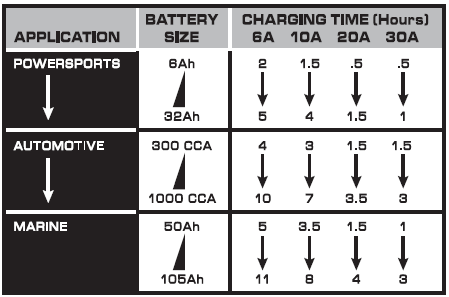
Times are based on a 50% discharged battery and may change, depending on the age and condition of the battery.
AUTOMATIC CHARGING MODE
When an Automatic Charge is performed, the charger switches to maintenance mode automatically after the battery is charged.
ABORTED CHARGE
If charging cannot be completed normally, charging will abort. When charging aborts, the charger’s output is shut off, and the CLAMPS REVERSED/BAD BATTERY ![]() (red) LED will light. Do not continue attempting to charge this battery. Check the battery and replace, if necessary.
(red) LED will light. Do not continue attempting to charge this battery. Check the battery and replace, if necessary.
DESULFATION MODE
Desulfation could take 8 to 10 hours. If desulfation fails, charging will abort, and the CLAMPS REVERSED/BAD BATTERY ![]() (red) LED will light.
(red) LED will light.
COMPLETION OF CHARGE
Charge completion is indicated by the CHARGED/MAINTAINING ![]() (green) LED. When pulsing, the charger has switched to the maintenance mode of operation.
(green) LED. When pulsing, the charger has switched to the maintenance mode of operation.
MAINTAIN MODE (FLOAT MODE MONITORING)
When the CHARGED/MAINTAINING ![]() (green) LED is pulsing, the charger has started maintain mode. In this mode, the charger keeps the battery fully charged by delivering a small current when necessary. If the charger has to provide its maximum maintain current for a continuous 112-hour period, it will go into abort mode (see Aborted Charge section). This is usually caused by a drain on the battery, or the battery could be bad. Make sure there are no loads on the battery. If there are, remove them. If there are none, have the battery checked or replaced.
(green) LED is pulsing, the charger has started maintain mode. In this mode, the charger keeps the battery fully charged by delivering a small current when necessary. If the charger has to provide its maximum maintain current for a continuous 112-hour period, it will go into abort mode (see Aborted Charge section). This is usually caused by a drain on the battery, or the battery could be bad. Make sure there are no loads on the battery. If there are, remove them. If there are none, have the battery checked or replaced.
MAINTAINING A BATTERY
The SC1305 charges and maintains 12-volt batteries, keeping them at full charge.
NOTE: The maintain mode technology allows you to safely charge and maintain a healthy battery for extended periods. However, problems with the battery, electrical problems in the vehicle, improper connections, or other unanticipated conditions could cause excessive current draws. As such, occasionally monitoring your battery and the charging process is required.
USING THE ENGINE START SETTING
Your battery charger can be used to jump-start your car if the battery is low. Follow all safety instructions and precautions for charging your battery. Wear complete eye and clothing protection.
WARNING: Using the ENGINE START setting WITHOUT a battery installed in the vehicle could cause damage to the vehicle’s electrical system.
NOTE: If you have charged the battery and it still will not start your car, do not use the Engine Start setting, or it could damage the vehicle’s electrical system. Have the battery checked.
- With the charger unplugged from the AC outlet, connect the charger to the battery, following the instructions given in Charging a Battery in the Vehicle.
- With the charger plugged in and connected to the battery of the vehicle, set the rate selection to the Engine Start position.
- Crank the engine until it starts or 5 seconds pass. If the engine does not start, wait a few minutes before cranking again. NOTE: During extremely cold weather, or if the battery is under 2 volts, use the 10A Boost setting for 5 minutes before cranking the engine.
- If the engine fails to start, boost the battery for 5 more minutes before attempting to crank the engine again.
- After the engine starts, unplug the AC power cord before disconnecting the battery clamps from the vehicle.
NOTE: If the engine does turn over but never starts, there nisonooproblem with the starting system; there is a problem somewhere else with the vehicle. STOP cranking the engine until the other problem has been diagnosed and corrected.
MAINTENANCE AND CARE
A minimal amount of care can keep your battery charger working properly for years.
- Clean the clamps each time you are finished charging. Wipe off any battery fluid that may have come in contact with the clamps to prevent corrosion.
- Occasionally, cleaning the case of the charger with a soft cloth will keep the finish shiny and help prevent corrosion.
- Coil the input and output cords neatly when storing the charger. This will help prevent accidental damage to the cords and charger.
- Store the charger unplugged from the AC power outlet in an upright position.
- Store inside, in a cool, dry place. Do not store the clamps clipped together, on the handle, on or around metal, or clipped to the cables.
TROUBLESHOOTING
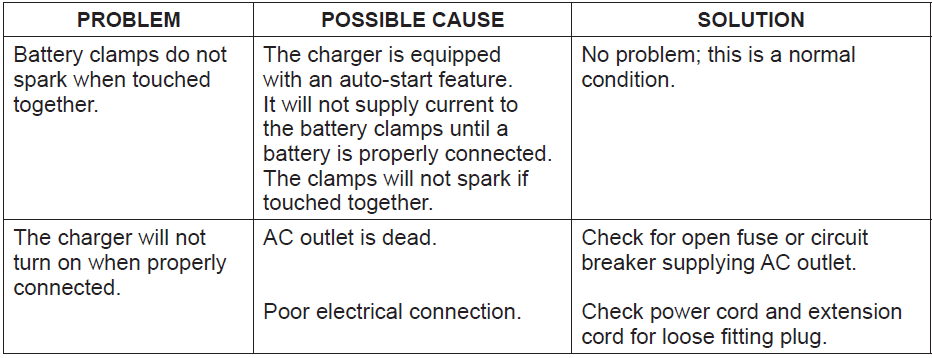
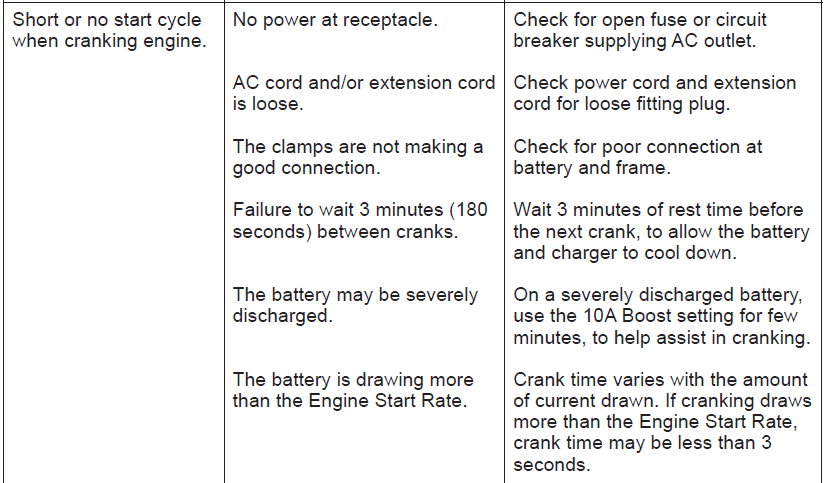
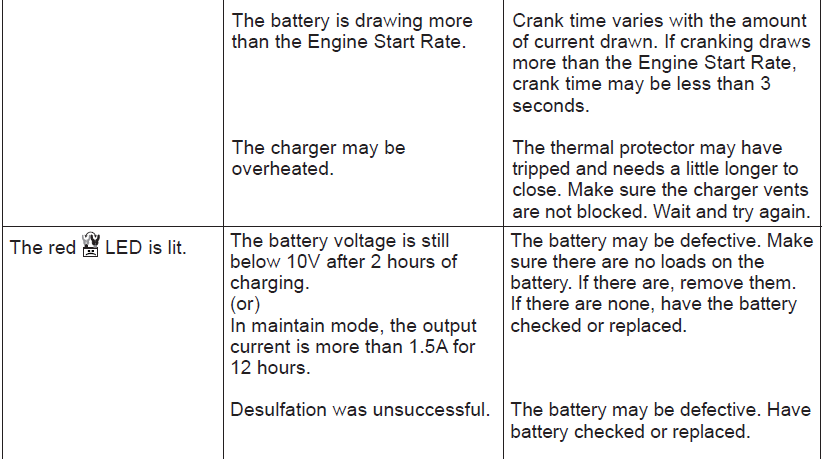
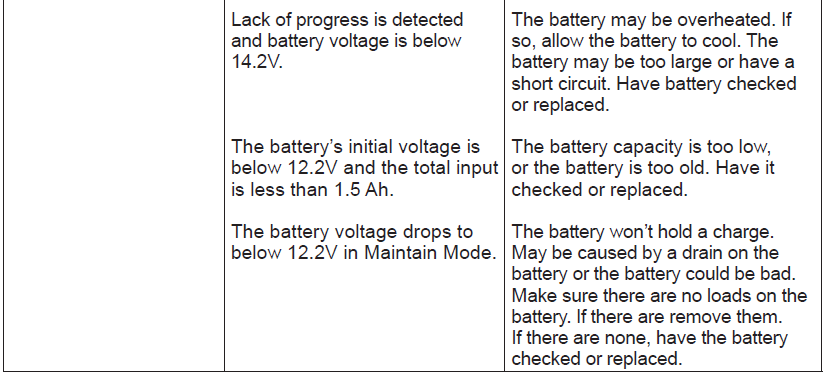
BEFORE RETURNING FOR REPAIRS
If these solutions do not eliminate the problem, or for troubleshooting information, contact customer service for assistance:
[email protected]
www.batterychargers.com
Or call 1-800-621-5485
Monday-Friday 7:00 am to 5:00 pm CST
For REPAIR OR RETURN, contact Customer Service at 1-800-621-5485. DO NOT SHIP UNIT until you receive a RETURN MERCHANDISE AUTHORIZATION (RMA) number from Customer Service at Schumacher Electric Corporation.
SPECIFICATIONS
- Input Voltage………………………………. 120V AC @ 60Hz, 2.2A Continuous/12A Intermittent
- Output Voltage……………………………………………………………………………………………12V DC
- Output Current Rating…………………………………………………………… 6<>2A/10A Continuous 50A Intermittent (10 sec. max. on; 180 sec. min. off)
LIMITED WARRANTY
WARRANTY NOT VALID IN MEXICO.
SCHUMACHER ELECTRIC CORPORATION, 801 BUSINESS CENTER DRIVE, MOUNT PROSPECT, IL 60056-2179, MAKES THIS LIMITED WARRANTY TO THE ORIGINAL RETAIL PURCHASER OF THIS PRODUCT. THIS LIMITED WARRANTY IS NOT TRANSFERABLE OR ASSIGNABLE.
Schumacher Electric Corporation (the “Manufacturer”) warrants this battery charger for two (2) years from the date of purchase at retail against defective material or workmanship that may occur under normal use and care. If your unit is not free from defective material or workmanship, the Manufacturer’s obligation under this warranty is solely to repair or replace your product with a new or reconditioned unit at the option of the Manufacturer. The purchaser must forward the unit, along with proof of purchase and mailing charges prepaid, to the Manufacturer or its authorized rrepresentativerepair or replacement to occur.
The manufacturer does not provide any warranty for any accessories used with this product that are not manufactured by Schumacher Electric Corporation and approved for use with this product. This Limited Warranty is void if the product is misused, subjected to careless handling, repaired, or modified by anyone other than the Manufacturer or me, if this unit is resold through an unauthorized retailer. The manufacturer may void this Limited Warranty if a “warranty void if removed” label is removed from the product.
The manufacturer makes no other warranties, including, but not limited to, express, implied, or statutory warranties, including without limitation, any implied warranty of merchantability or implied warranty of fitness for a particular purpose. Further, Manufacturer shall not be liable for any incidental, spec,ial, or consequential damage claims incurred by purchasers, users,, or others associated with this product, including, but not limited to, lost profits, revenues, anticipated sales, business opportunities, goodwill, business interruption and any other injury or damage. Any such warranties, other than the limited warranty included herein, are hereby expressly disclaimed and excluded. Some states do not allow the exclusion or limitation of incidental or consequential damages or the length of implied warranty, so the above limitations or exclusions may not apply to you. This warranty gives you specific legal rights; howevhave rightsgtthatvary from this warranty.
THIS LIMITED WARRANTY IS THE ONLY EXPRESS LIMITED WARRANTY, AND THE MANUFACTURER NEITHER ASSUMES NOR AUTHORIZES ANYONE TO ASSUME OR MAKE ANY OTHER OBLIGATION TOWARDS THE PRODUCT OTHER THAN THIS WARRANTY.
For more manuals by Schumacher, visit ManualsLibraryy
Schumacher SC1305 Automatic Battery Charger- FAQs
How long does it take to charge a battery with the Schumacher SC1305?
6 Amp Mode: Charges in 6–8 hours (ideal for most car batteries).
2 Amp Mode (Trickle Charge): Takes 2–12 hours (best for small 12V batteries).
How do I know if my Schumacher charger is working?
The ammeter needle will show the charging rate (e.g., if set to 12A, it starts near 12 and drops to ~6A when nearly full).
A blinking green light means charging; solid green means fully charged.
Can I leave the Schumacher SC1305 charger on overnight?
✅ Yes – It automatically switches to Maintenance Mode (Float Mode) once fully charged to prevent overcharging.
⚠️ Do not leave it connected indefinitely (disconnect after 24–48 hours).
Why does my Schumacher charger keep shutting off?
Possible reasons:
Battery overheating (charger stops to prevent damage).
Faulty battery (test or replace it).
Blocked charger vents (ensure proper ventilation).
What does the blinking green light mean?
Blinking green: Battery is charging.
Solid green: Battery is fully charged.
Can the SC1305 charge a completely dead battery?
✅ Yes! Unlike some chargers, it can revive deeply discharged batteries (even at 0V).
What is the snowflake symbol (❄️) on the charger?
Indicates cold-weather charging mode (slower, safer charging for winterized vehicles like motorcycles).
Does the charger stop when the battery is full?
✅ Yes – It automatically switches to Maintenance Mode to avoid overcharging.
What’s the best amp setting for charging?
2A–10A: Safe for most batteries (prevents overheating).
Higher amps (10A+): Faster charge but not recommended for long-term use.
How do I test if my battery charger is working?
Check the ammeter needle (should move when connected).
Use a multimeter to verify voltage output (~13–14V when charging).

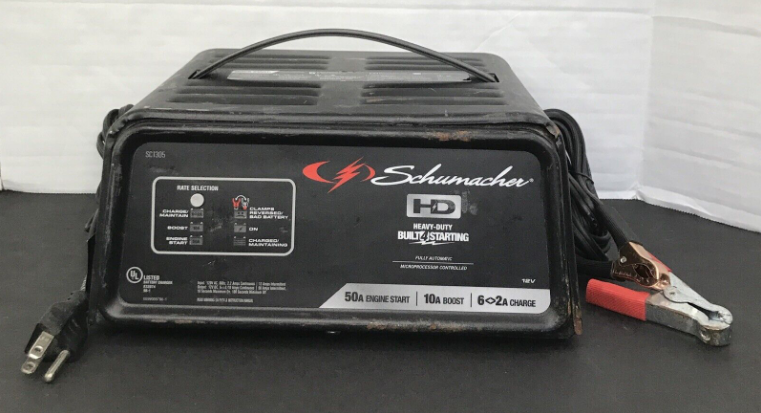
 *AWG-American Wire Gauge
*AWG-American Wire Gauge